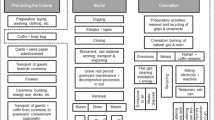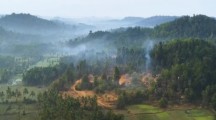Abstract
This ethnoarchaeological study examines sociopolitical constraints on traditional pottery production in Paradijon, southern Luzon, the Philippines. Factionalism divided the potting community as it became involved in elite competition and dictated that the two potting factions acquire clays from sources controlled by elite alliance partners. This study examines patterning in instrumental neutron activation analysis (INAA) data in relationship to the involvement of independent craft specialists in elite competition. Patterning of INAA data at community and regional levels is found, illustrating the middle-range links between sociopolitical behavior of potters and patterns in clay composition. INAA patterning among clay preparation areas appears dependent on whether a preparation area is in public or private space. Regionally, primary markets express INAA signals from both factions, whereas secondary markets reflect potter participation of a particular faction.
Similar content being viewed by others
REFERENCES CITED
Arnold, D. (1980). Localized exchange: An ethnoarchaeological perspective. In Fry, R. (ed.), Models and Methods in Regional Exchange, SAA Papers 1, Society for American Archaeology, Washington DC, pp. 147–150.
Arnold, D. (1985). Ceramic Theory and Cultural Process, Cambridge University Press, Cambridge.
Arnold, D., Neff, H., and Bishop, R. (1991). Compositional analysis and “sources” of pottery: An ethnoarchaeological approach. American Anthropologist 92: 915–932.
Arnold, D., Rice, P., Jester, R., Deustch, W., Lee, B., and Kirsch, R. (1978). Neutron activation analysis of contemporary pottery and pottery materials from the Valley of Guatemala. In Wetherington, R.K. (ed.), Ceramics of Kaminaljuyu, Guatemala, Pennsylvania State University Press, University Park, pp. 543–586.
Bishop, R., and Neff, H. (1989). Compositional data analysis in archaeology. In Allen, R. O. (ed.), Archaeological Chemistry, Vol. IV, American Chemical Society, Washington, DC, pp. 57–86.
Bishop, R., Rands, R., and Holley, G. (1982). Ceramic compositional analysis in archaeological perspective. In Schiffer, M. (ed.), Advances in Archaeological Method and Theory, Vol. 5, Academic Press, New York, pp. 275–330.
Brumfiel, E. (1989). Factional competition in complex society. In Miller, D., Rowlands, M., and Tilley, C. (eds.), Domination and Resistance, Unwin Hyman Ltd., London, pp. 127–137.
Brumfiel, E. (1992). Distinguished lecture in archaeology: Breaking and entering the ecosystem-gender, class, and faction steal the show. American Anthropologist 94(3): 551–567.
Brumfiel, E. (1994). Factional competition and political development in the New World: An introduction. In Brumfiel, E., and Fox, J. (eds.), Factional Competition and Political Development in the New World, Cambridge University Press, Cambridge, pp. 1–14.
Brumfiel, E., and Earle, T. (1987). Specialization, exchange, and complex societies: An introduction. In Brumfiel, E., and Earle, T. (eds.), Specialization, Exchange, and Complex Societies, Cambridge Unversity Press, Cambridge, pp. 1–9.
Costin, C. (1991). Craft specialization: Issues in defining, documenting, and explaining the organization of craft production. In Schiffer, M. (ed.), Archaeological Method and Theory, Vol 3, University of Arizona Press, Tucson, pp. 1–56.
Earle, T. (1981). Comment on P. Rice, Evolution of specialized pottery production: A trial model. Current Anthropology 22(3): 230, 231.
Gero, J. (1983). Material Culture and the Reproduction of Social Complexity: A Lithic Example from the Peruvian formative, Ph.D. dissertation, University of Massachusetts: University Microfilms, Ann Arbor.
Hagstrum, M. (1985). Measuring prehistoric ceramic craft specialization: A test case in the American Southwest. Journal of Field Archaeology 12(1): 65–76.
Hagstrum, M. (1989). Technological Continuity and Change: Ceramic Ethnoarchaeology in the Peruvian Andes, Ph.D. dissertation, University of California, Los Angeles: University Microfilms, Ann Arbor.
Kramer, C. (1991). Ceramics in two Indian cities. In Longacre, W. (ed.), Ceramic Ethnoarchaeology, University of Arizona Press, Tucson, pp. 205–230.
London, G. (1991). Standardization and variation in the work of craft specialists. In Longacre, W. (ed.), Ceramic Ethnoarchaeology, University of Arizona Press, Tucson, pp. 182–204.
Neupert, M. (1999). Potters and Politics: Factionalism and the Organization of Ceramic Production in Paradijon, the Philippines, Ph.D. dissertation, University of Arizona, Tucson: University Microfilms, Ann Arbor.
Rice, P. (1977). Whiteware pottery production in the Valley of Guatemala: Specialization and resource utilization. Journal of Field Archaeology 4: 221–223.
Rice, P. (1978a). Ceramic continuity and change in the Valley of Guatemala: A technological analysis. In Wetherington, R.K. (ed.), Ceramics of Kaminaljuyu, Guatemala, Pennsylvania State University Press, University Park, pp. 401–510.
Rice, P. (1978b). Clear answers to vague questions: Some assumptions of provenience studies of pottery. In Wetherington, R.K. (ed.), Ceramics of Kaminaljuyu, Guatemala, Pennsylvania State University Press, University Park, pp. 511–542.
Rice, P. (1987). Pottery Analysis: A Sourcebook, University of Chicago Press, Chicago.
Rice, P. (1996). Recent ceramic analysis: 2. Composition, production, and theory. Journal of Archaeological Research 4: 165–202.
Russell, G. (1988). The Impact of Inka Policy on the Domestic Economy of Wanka, Peru: Stone Tool Production and Use, Ph.D. dissertation, University of California, Los Angeles: University Microfilms, Ann Arbor.
Sullivan, A. (1988). Prehistoric southwestern ceramic manufacture: The limitations of current evidence. American Antiquity 53(1): 23–35.
Rights and permissions
About this article
Cite this article
Neupert, M.A. Clays of Contention: An Ethnoarchaeological Study of Factionalism and Clay Composition. Journal of Archaeological Method and Theory 7, 249–272 (2000). https://doi.org/10.1023/A:1026562604895
Issue Date:
DOI: https://doi.org/10.1023/A:1026562604895




